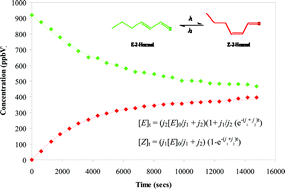The atmospheric photolysis of E-2-hexenal, Z-3-hexenal and E,E-2,4-hexadienal†
Abstract
The atmospheric photolysis of

* Corresponding authors
a
Department of Chemistry and Environmental Research Institute, University College Cork, Cork, Ireland
E-mail:
j.wenger@ucc.ie
Fax: +353 21 4903014
Tel: +353 21 4902454
b Laboratoire de Combustion et Systèmes Réactifs, CNRS, Orléans, Cedex 2, France
c Centro de Estudios Ambientales del Mediterraneo, C. Charles R. Darwin 14 Paterna, Valencia, Spain
The atmospheric photolysis of

 Please wait while we load your content...
Something went wrong. Try again?
Please wait while we load your content...
Something went wrong. Try again?
M. P. O’Connor, J. C. Wenger, A. Mellouki, K. Wirtz and A. Muñoz, Phys. Chem. Chem. Phys., 2006, 8, 5236 DOI: 10.1039/B611344C
To request permission to reproduce material from this article, please go to the Copyright Clearance Center request page.
If you are an author contributing to an RSC publication, you do not need to request permission provided correct acknowledgement is given.
If you are the author of this article, you do not need to request permission to reproduce figures and diagrams provided correct acknowledgement is given. If you want to reproduce the whole article in a third-party publication (excluding your thesis/dissertation for which permission is not required) please go to the Copyright Clearance Center request page.
Read more about how to correctly acknowledge RSC content.
 Fetching data from CrossRef.
Fetching data from CrossRef.
This may take some time to load.
Loading related content
